Daniel S. Goldin served as NASA’s ninth and longest serving administrator between 1992 and 2001. Nominated by President George H.W. Bush, Goldin also served under Presidents William J. “Bill” Clinton and George W. Bush. Early in his administration, he revived NASA’s original blue logo. His tenure in office saw increased cooperation with Russia and other international partners, leading to the Shuttle-Mir and International Space Station programs. Permanent human occupancy of space began during his term in office. In an era of constrained federal budgets, Goldin reduced NASA’s workforce and redirected science projects toward more frequent but smaller and less-costly efforts. He provided renewed emphasis on aeronautics research and revitalized NASA’s Earth observation program. He resigned from NASA effective November 2001.
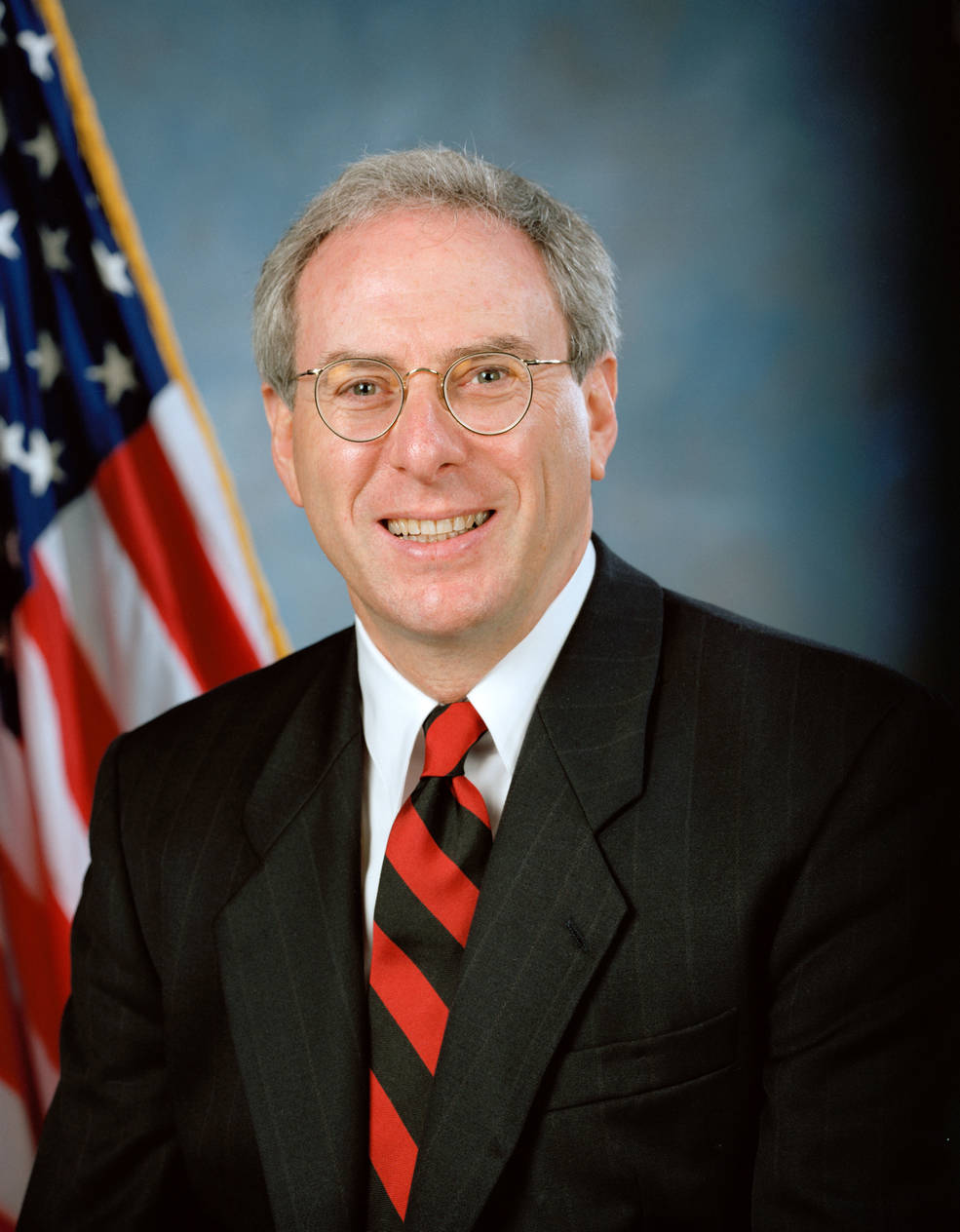
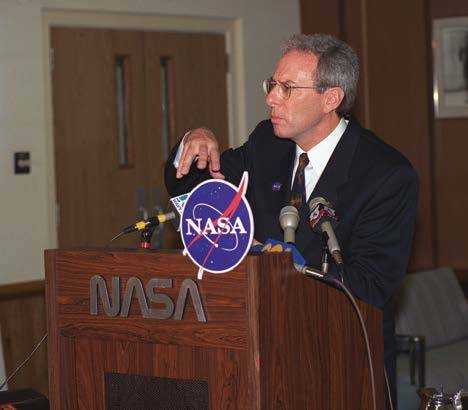
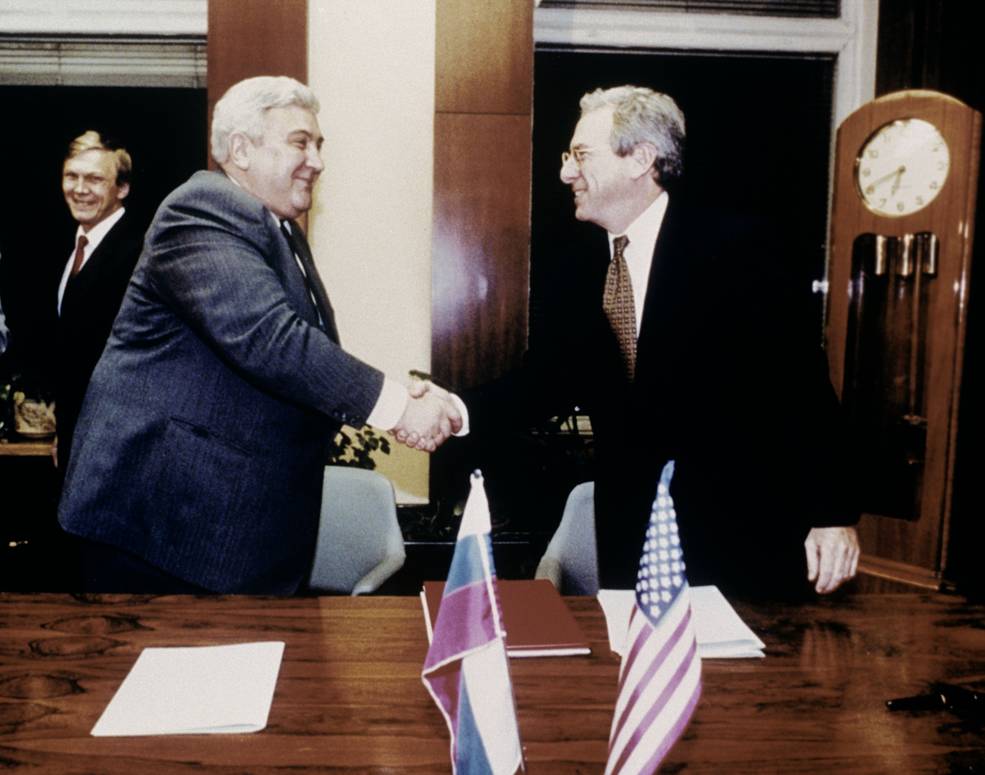
Left: Official portrait of Daniel S. Goldin, NASA’s ninth administrator. Middle: Goldin with the newly-revived “meatball” NASA logo and the old “worm” logo that he retired. Right: Goldin, right, shakes hands with his counterpart Yuri N. Koptev, general director of the Russian Space Agency, now Roscomos, after signing a cooperation agreement in 1992 that led to the Shuttle-Mir program.
After earning a Bachelor of Science degree in mechanical engineering from the City College of New York in 1962, Goldin began working at NASA’s Lewis (now Glenn) Research Center in Cleveland, Ohio. He left NASA five years later to join the TRW Space and Technology Group in Redondo Beach, California, rising to the position of Vice President and General Manager after a 25-year career. At TRW, he managed several projects for NASA and the Department of Defense. President Bush nominated and the Senate confirmed him to succeed Richard H. Truly as NASA Administrator. Goldin took office on April 1, 1992. Sensing the agency needed a morale boost, during an early visit to NASA’s Langley Research Center in Hampton, Virginia, Goldin announced his direction to revive the official red, white, and blue “meatball” NASA logo in use during the 1960s, retiring the red and white “worm” logo that Administrator James C. Fletcher had instituted in 1975. Among his other early accomplishments with long-lasting effects, Goldin developed closer ties with Russia, then in the aftermath of the collapse of the Soviet Union. The early agreement to fly a Russian cosmonaut on the space shuttle and an American astronaut on space station Mir led first to the Shuttle-Mir program and ultimately to including Russia as a full partner as space station Freedom evolved into the International Space Station.
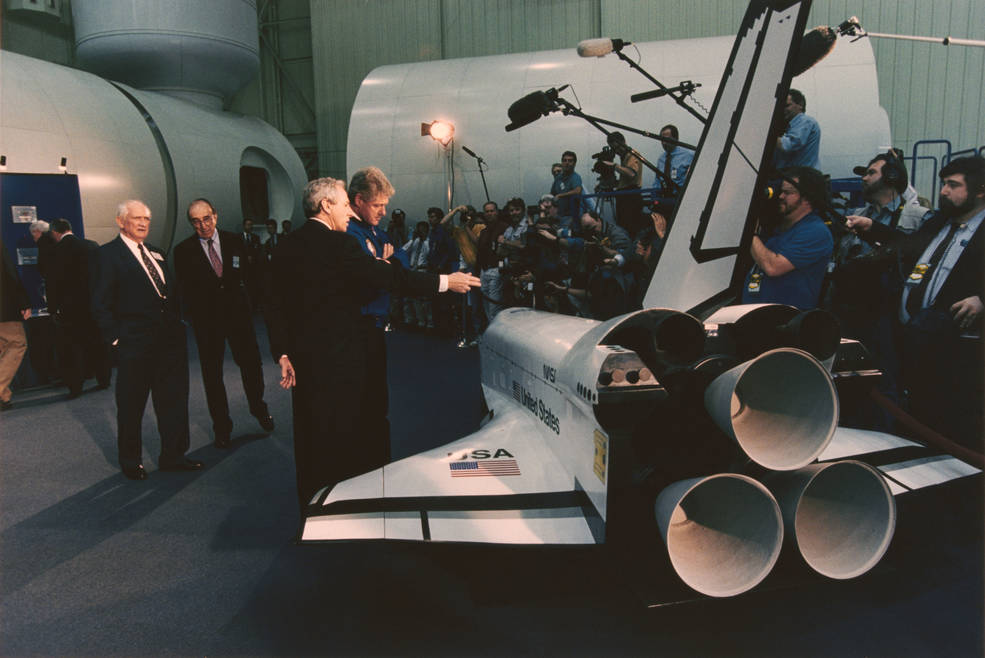
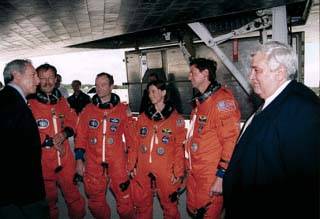
Left: In February 1994, NASA Administrator Daniel S. Goldin, left, describes a model of the space shuttle during President William J. “Bill” Clinton’s visit to NASA’s Johnson Space Center in Houston. Right: In July 1995, Goldin, left, greets the STS-71 crew at NASA’s Kennedy Space Center in Florida following their successful first docking mission with the space station Mir with Russian Space Agency, now Roscomos, General Director Yuri N. Koptev, right.
Goldin arrived at NASA at a time when many outside observers viewed the agency as a bloated bureaucracy. He reduced the civil service workforce by about one third, and reduced the civil service and contractor workforce at NASA Headquarters in Washington, D.C., by more than half, accomplishing these results without any forced layoffs. Goldin pioneered the “faster, better, cheaper” approach to cut costs in new science projects while still delivering timely results. While overall successful, the approach later drew criticism following the much-publicized failures of two robotic missions, Mars Climate Observer and Mars Polar Lander in 1999. On the other hand, the Mars Global Surveyor orbiter and the Mars Pathfinder lander and its Sojourner rover proved highly successful, as did the Mars Odyssey orbiter, operating in orbit around Mars since 2001.
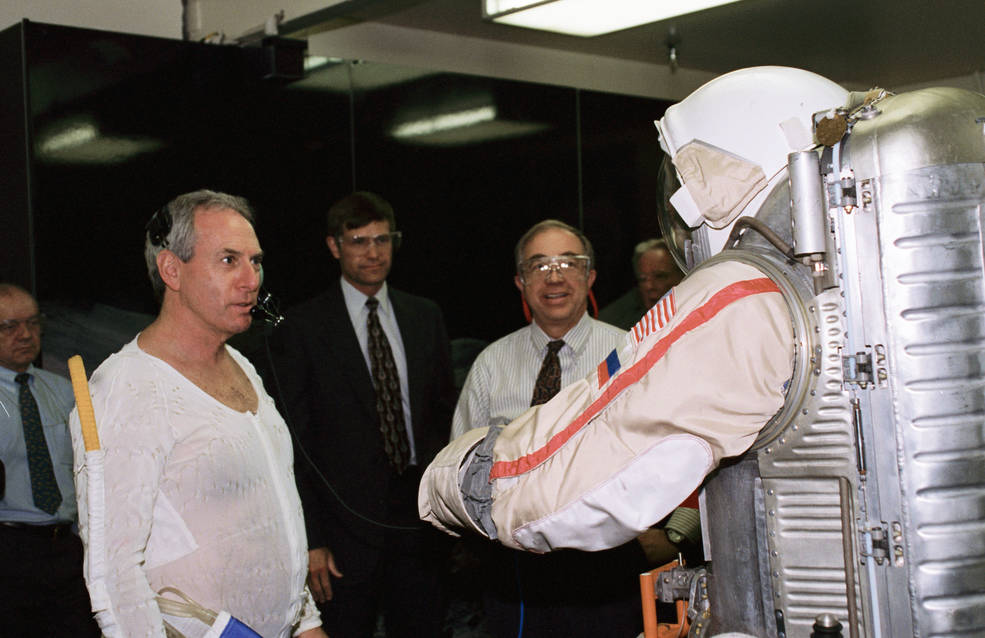
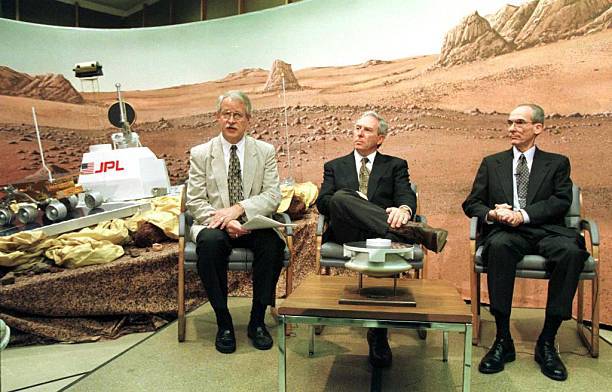
Left: At NASA’s Johnson Space Center in Houston in October 1996, NASA Administrator Daniel S. Goldin, left, prepares to try on a Russian Orlan extravehicular spacesuit. Right: In July 1997, at NASA’s Jet Propulsion Laboratory (JPL) in Pasadena, California, Goldin, center, meets the press with NASA Associate Administrator for Space Sciences Wesley T. Huntress, left, and JPL Director Edward C. Stone, right, to discuss the landing of the Mars Pathfinder and its Sojourner rover.
Goldin began his tenure during the STS-45 mission. On his second day in office, he greeted the crew, commanded by future NASA Administrator Charles F. Bolden, upon its landing at NASA’s Kennedy Space Center in Florida. During his nearly decade-long term in office, Goldin oversaw 60 more space shuttle missions, including the first flight of the orbiter Endeavour that also saw the first three-person spacewalk, the 11 flights of the Shuttle-Mir program, three of the six servicing missions to the Hubble Space Telescope, the launch of the Chandra X-Ray Observatory on the first space shuttle flight commanded by a woman, Eileen M. Collins, the first 11 space station assembly missions, and numerous Spacelab and other science flights. In the area of space science, Goldin’s “faster, better, cheaper” approach resulted in a significant increase in the number of planetary and science missions, many developed within the framework of the Discovery program that supported a range of small and low-cost spacecraft. Goldin revitalized NASA’s aeronautics programs, the first “A” in NASA, and brought renewed emphasis to Earth sciences.
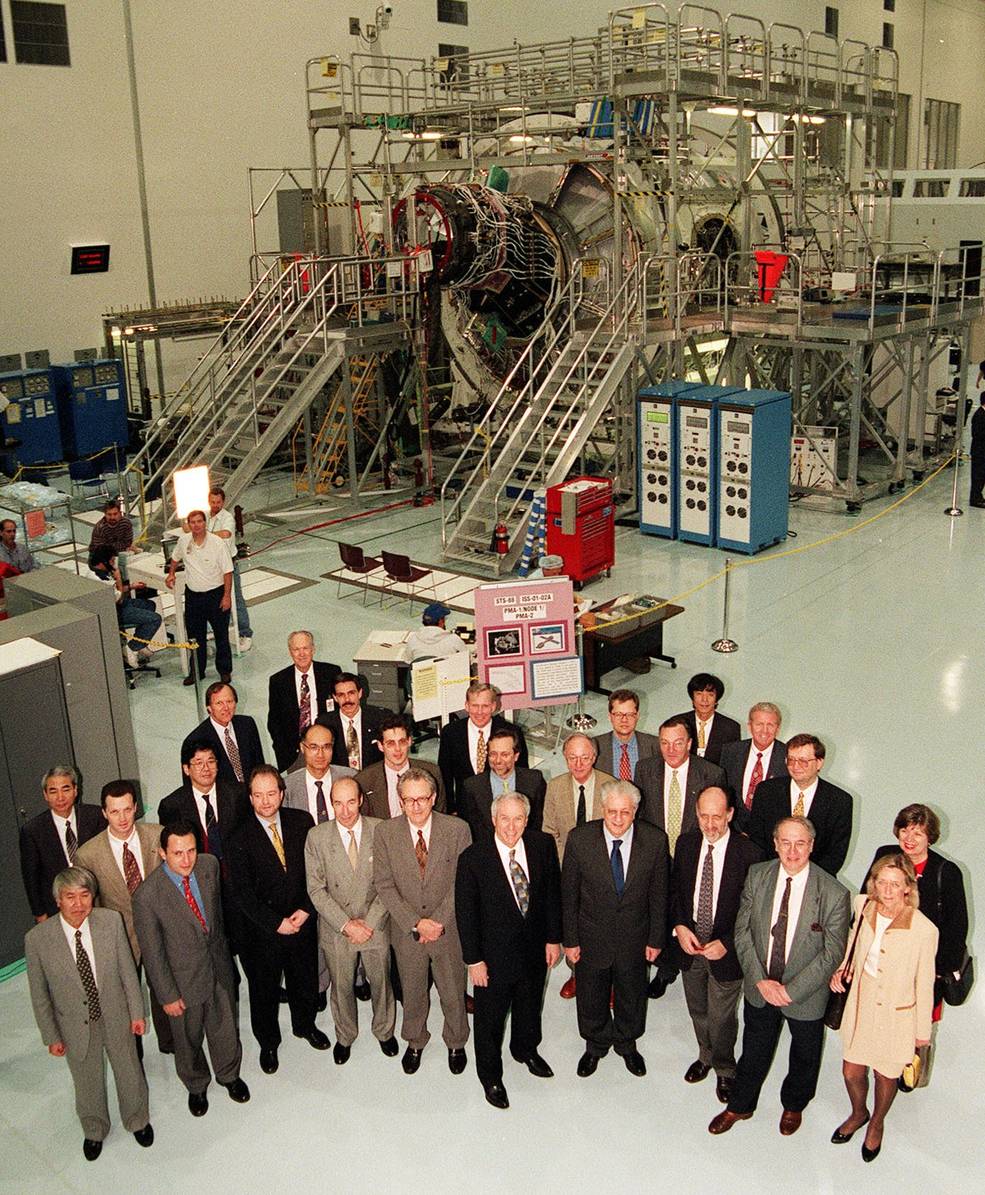
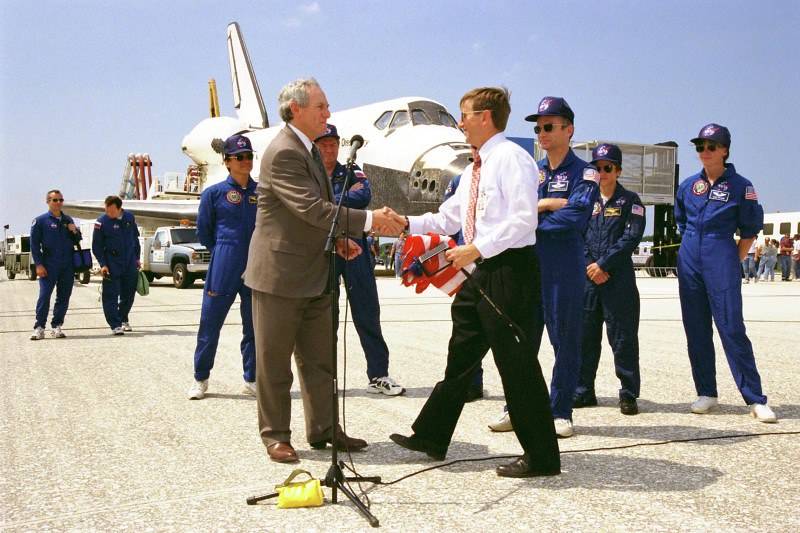
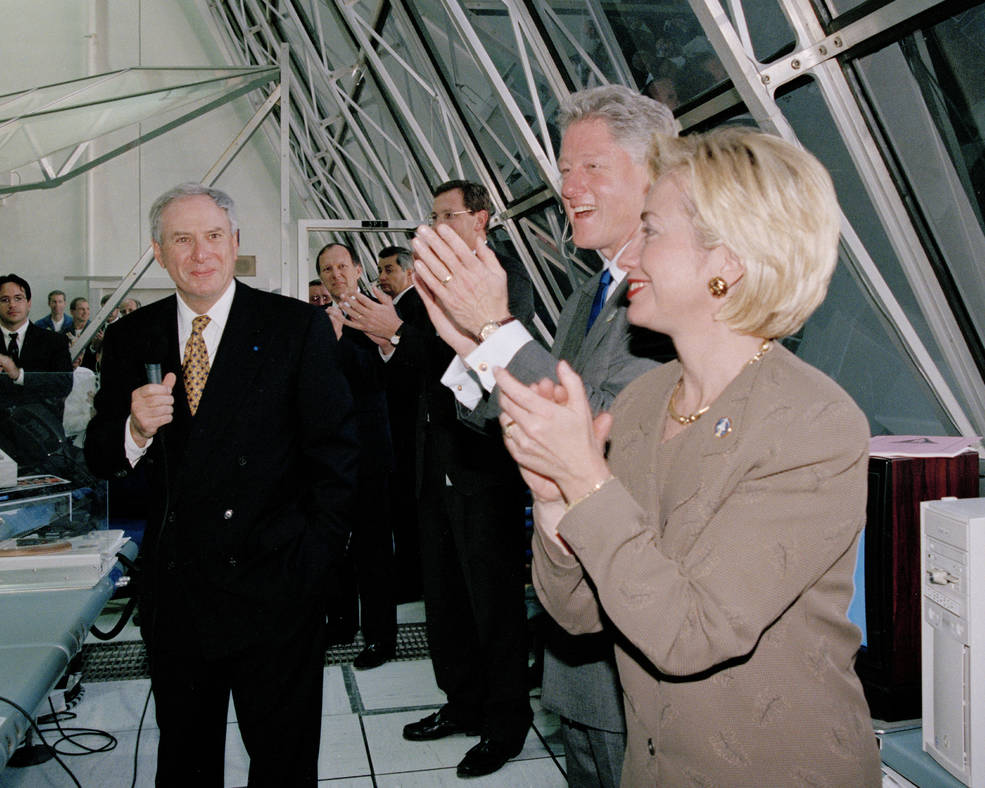
Left: At NASA’s Kennedy Space Center (KSC) in Florida, NASA Administrator Daniel S. Goldin, center, poses with members of international partner delegations following the signing of the space station Inter-Governmental Agreement in January 1998. Middle: Following the STS-91 landing at KSC in June 1998, Goldin, left, shakes hands with Program Manager Frank L. Culbertson to mark the conclusion of the Shuttle-Mir Program. Right: In October 1998, in KSC’s Firing Room, Goldin congratulates the launch team on the successful liftoff of STS-95, as President William J. “Bill’ Clinton and First Lady Hillary Rodham Clinton applaud.
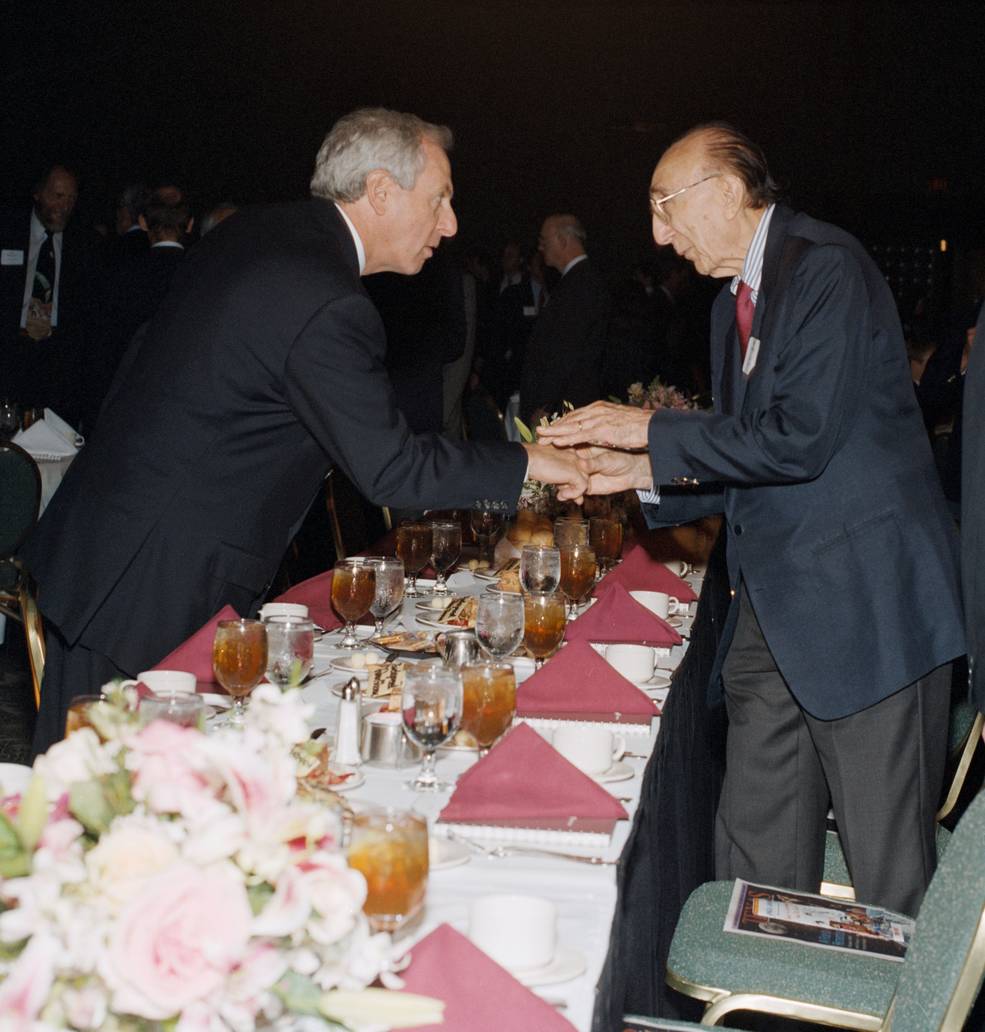
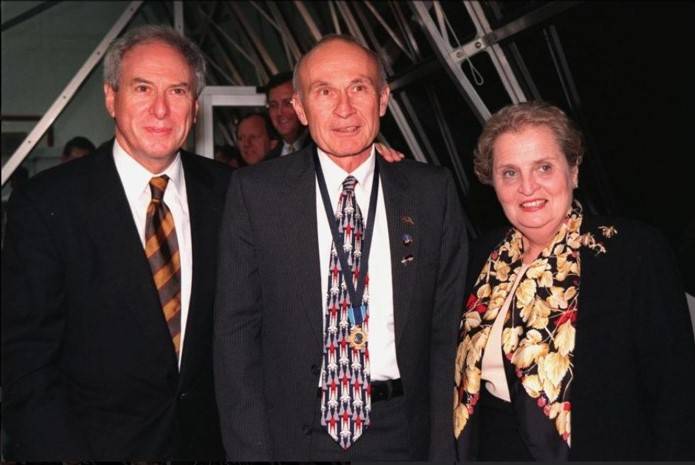
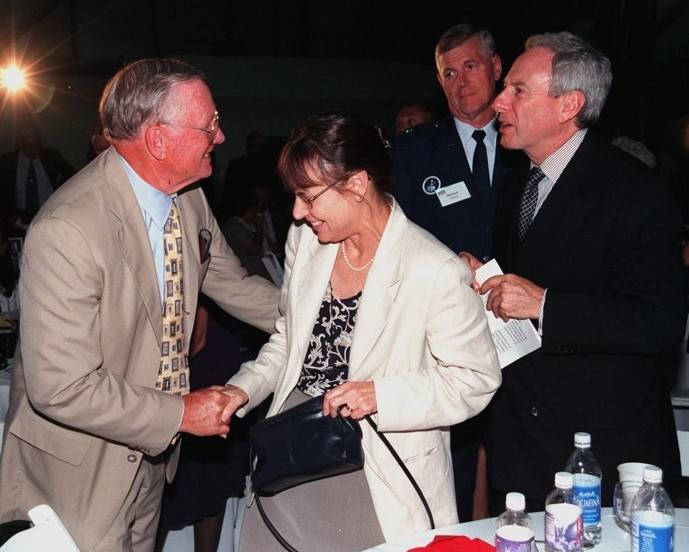
Left: NASA Administrator Daniel S. Goldin, left, shakes hands with famed heart surgeon Dr. Michael E. DeBakey of Baylor College of Medicine at NASA’s 40th anniversary celebration in Houston in November 1998. Middle: In the Launch Control Center at NASA’s Kennedy Space Center (KSC) in Florida following the launch of STS-88 in December 1998, Goldin, left, poses with Launch Director Robert B. “Bob” Sieck and Secretary of State Madeline J.K. Albright. Right: Goldin, right, with wife Judy shaking hands with Neil A. Armstrong, at KSC during an Apollo 11 30th anniversary celebration in July 1999.
With space station Freedom facing increasing budgetary pressures in 1993, Goldin led an effort to redesign the planned orbiting facility. A novel aspect of the redesign sought to leverage cooperation with Russia to bring their decades of experience with long-duration spaceflight and for Russia to potentially contribute hardware elements to reduce the cost of the facility and accelerate its development schedule. The redesigned space station passed by a single vote in the U.S. House of Representatives in June 1993, and NASA formally invited Russia to join the program in October. The Shuttle-Mir program evolved out of initial plans for each country to fly the other’s crew members, and served as a testbed for the two nations to learn to work together in space. Seven American astronauts completed long-duration missions aboard space station Mir between 1995 and 1998. In January 1998, the international partners signed an Intergovernmental Agreement to establish the working relationships for the space station. The facility’s first element launched in November 1998 and the first long-duration crew took up residence two years later. Of that event, Goldin commented, “We’re going to be in space forever with people.” And indeed, international crews have occupied the orbiting facility on a rotating basis ever since, conducting thousands of experiments.
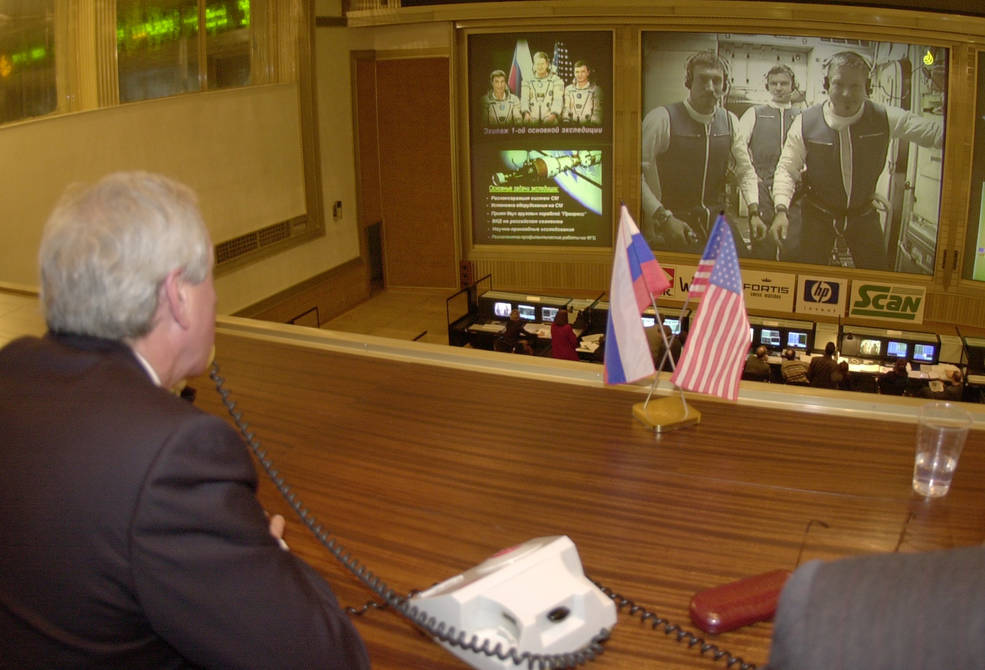
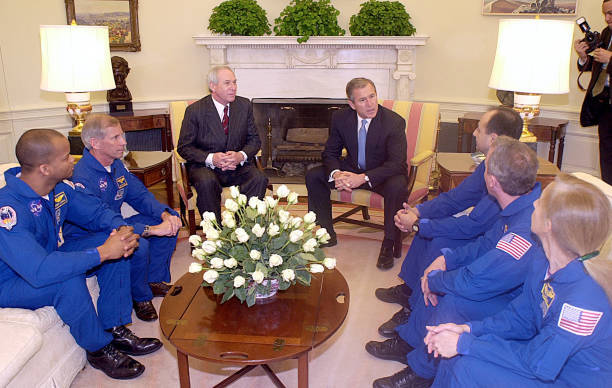
Left: In the Russian Flight Control Center outside Moscow, NASA Administrator Daniel S. Goldin, left,speaks with the Expedition 1 crew, recently arrived to begin permanent human occupancy of the International Space Station in November 2000. Right: In March 2001, Goldin, third from left, at the White House with President George W. Bush and the STS-98 astronauts to celebrate their successful mission that delivered the U.S. Laboratory module Destiny to the space station.
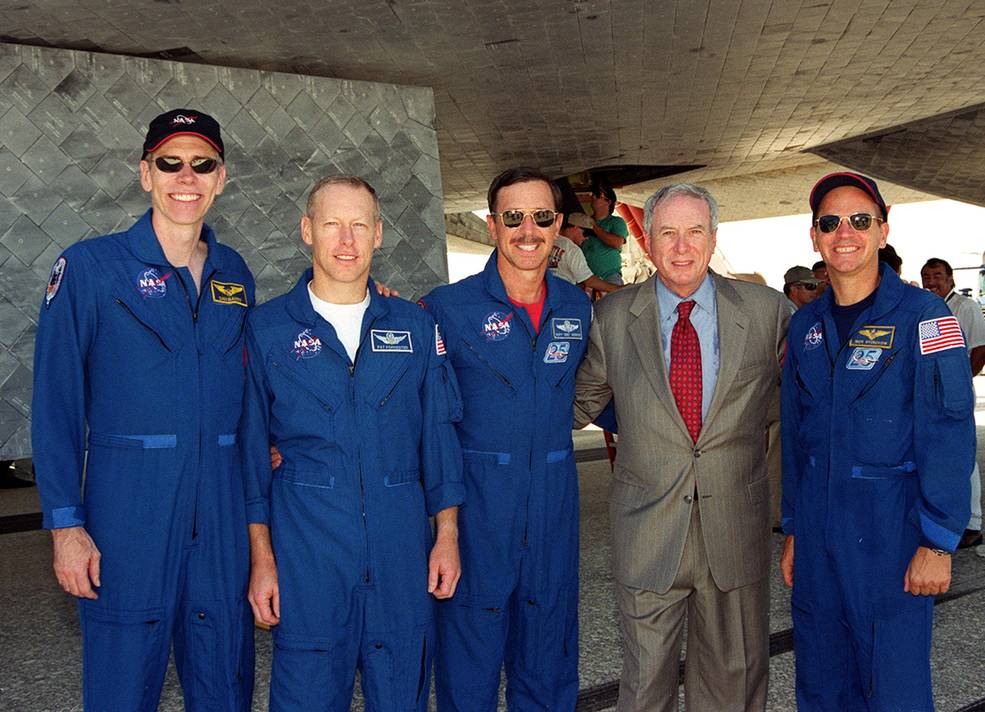
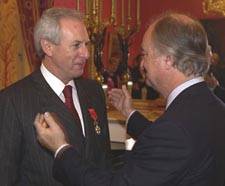
Left: In August 2001 at NASA’s Kennedy Space Center in Florida, NASA Administrator Daniel S. Goldin, second from right, greets a space shuttle crew, the STS-105 astronauts, for the final time as administrator. Right: In October 2001, Goldin, left, with French Ambassador to the United States Bujon de l’Estang after receiving the French Legion of Honor medal.
Goldin announced his resignation from NASA on Oct. 17, 2001, effective Nov. 17. In an address to NASA employees, he told them, “You are the greatest. It was easy being administrator. It’s going to be very hard walking out that door. I’ll always have NASA in my heart.” With a vacancy in the NASA deputy administrator position at the time, Associate Deputy Administrator Daniel R. Mulville served as interim acting administrator until the Senate confirmed Goldin’s successor Sean C. O’Keefe on Dec. 21. Among other accolades, during his tenure as administrator Goldin received the National Space Trophy from the Rotary National Award for Space Achievement Foundation in 1995, the Laurel Award from the prestigious aerospace trade journal Aviation Week & Space Technology in 1998, and the French Legion of Honor medal in 2001.
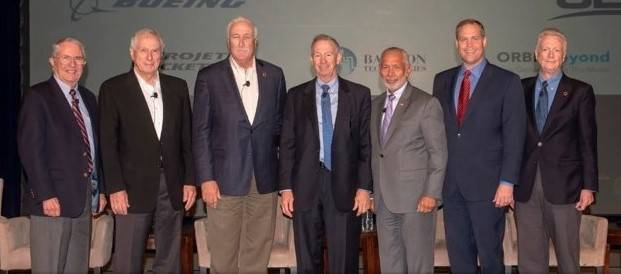
A rare joint public appearance of NASA administrators in September 2018, during an event celebrating NASA’s 60th anniversary – former Administrators Richard H. Truly, left, Daniel S. Goldin, Sean C. O’Keefe, Michael D. Griffin, Charles F. Bolden, then-current Administrator James F. “Jim” Bridenstine, and former
NASA Chief Historian Roger D. Launius. Credit: Image courtesy American Institute of Aeronautics and Astronautics.





























